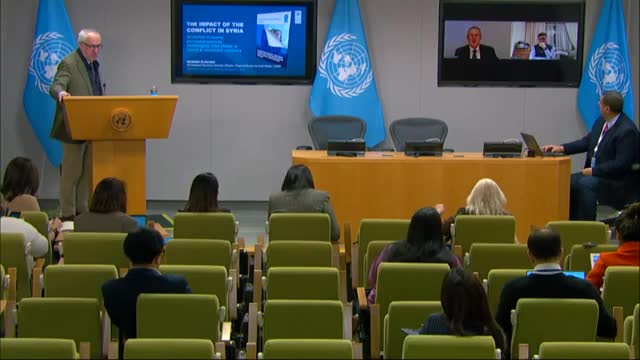UN team reveals devastating impact of Syria war on human development and economy
February 22, 2025 | United Nations, Federal
This article was created by AI summarizing key points discussed. AI makes mistakes, so for full details and context, please refer to the video of the full meeting. Please report any errors so we can fix them. Report an error »

The recent United Nations press conference highlighted the staggering socioeconomic impact of 14 years of conflict in Syria, revealing a humanitarian crisis that continues to deepen. The discussions, led by UN representatives, emphasized the urgent need for a comprehensive recovery plan as the country grapples with unprecedented challenges.
Key findings from the UN report indicate that the conflict has resulted in the loss of approximately 618,000 lives, making it one of the deadliest conflicts in recent history. The situation is further exacerbated by the forced disappearance of 113,000 individuals and the displacement of over half the population, with 7.2 million internally displaced persons (IDPs) and 6 million refugees seeking safety outside the country.
Economically, Syria has suffered catastrophic losses, with its GDP declining by more than half since the onset of the war. Today, a staggering 90% of the population lives in poverty, a threefold increase since 2010. Extreme poverty affects 66% of the population, compared to just 11% a decade ago. Unemployment has surged from 8% to 24%, leaving 5.4 million people without jobs. The reliance on humanitarian assistance has reached alarming levels, with 16.5 million Syrians dependent on aid.
Food security remains a critical issue, with 52% of the population facing severe food insecurity. The energy sector has also been devastated, with 80% of the country’s energy capacity lost and 70% of power plants damaged. Housing conditions are dire, with 5.7 million people in need of shelter support due to the destruction of homes.
Perhaps the most striking statistic presented was the decline in Syria's Human Development Index (HDI), which has plummeted to 0.557—lower than any recorded level since 1990. This decline signifies a loss of 40 years of human development progress, underscoring the urgent need for recovery efforts.
The UN is actively working on a transition and recovery framework, with the United Nations Development Programme (UNDP) preparing scenarios for economic and social recovery. However, the path to recovery is daunting; if Syria continues to grow at the average rate of 1.3% per year, it would take an estimated 55 years to return to its 2010 GDP levels.
As the international community looks toward recovery efforts, the pressing need for support and intervention remains clear. The discussions at the UN serve as a reminder of the profound impact the conflict has had on the lives of millions and the critical importance of coordinated efforts to rebuild and restore hope in Syria.
Key findings from the UN report indicate that the conflict has resulted in the loss of approximately 618,000 lives, making it one of the deadliest conflicts in recent history. The situation is further exacerbated by the forced disappearance of 113,000 individuals and the displacement of over half the population, with 7.2 million internally displaced persons (IDPs) and 6 million refugees seeking safety outside the country.
Economically, Syria has suffered catastrophic losses, with its GDP declining by more than half since the onset of the war. Today, a staggering 90% of the population lives in poverty, a threefold increase since 2010. Extreme poverty affects 66% of the population, compared to just 11% a decade ago. Unemployment has surged from 8% to 24%, leaving 5.4 million people without jobs. The reliance on humanitarian assistance has reached alarming levels, with 16.5 million Syrians dependent on aid.
Food security remains a critical issue, with 52% of the population facing severe food insecurity. The energy sector has also been devastated, with 80% of the country’s energy capacity lost and 70% of power plants damaged. Housing conditions are dire, with 5.7 million people in need of shelter support due to the destruction of homes.
Perhaps the most striking statistic presented was the decline in Syria's Human Development Index (HDI), which has plummeted to 0.557—lower than any recorded level since 1990. This decline signifies a loss of 40 years of human development progress, underscoring the urgent need for recovery efforts.
The UN is actively working on a transition and recovery framework, with the United Nations Development Programme (UNDP) preparing scenarios for economic and social recovery. However, the path to recovery is daunting; if Syria continues to grow at the average rate of 1.3% per year, it would take an estimated 55 years to return to its 2010 GDP levels.
As the international community looks toward recovery efforts, the pressing need for support and intervention remains clear. The discussions at the UN serve as a reminder of the profound impact the conflict has had on the lives of millions and the critical importance of coordinated efforts to rebuild and restore hope in Syria.
View full meeting
This article is based on a recent meeting—watch the full video and explore the complete transcript for deeper insights into the discussion.
View full meeting